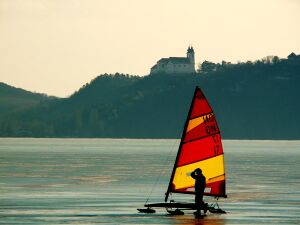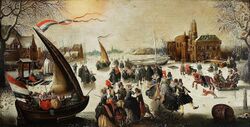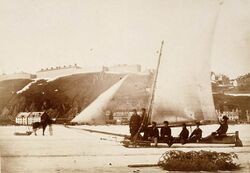Engineering:Ice boat
An ice boat (often spelled as "iceboat") is a boat or purpose-built framework similar in functional design to a sail boat but fitted with skis or runners (skates) and designed to run over ice instead of through (liquid) water. Ice yachting is the sport of sailing and racing iceboats. Sail-able ice is known in the sport as "hard water" versus sailing on liquid or "soft" water. A related sport, land sailing, utilizes a configuration with an iceboat-like fuselage or frame equipped with wheels instead of runners. Iceboats commonly used for racing are usually only for one person, but several classes of two-seat and multiple-seat iceboats are more or less common. On some boats, a "side car" can be fitted to take others along for a ride.
History
Traditional iceboats from before the late 19th century were used for transportation of goods and racing. These boats reached lengths of 30 to 50 feet (9.1 to 15.2 m) and were sometimes transported between sites on rail cars. Ice sailing was first developed in Europe. In America, it was done in several locations where the sport also continues today. Many active ice sailing clubs are thriving in the northern States and Canadian Provinces, including on the Hudson River; Long Island Sound; Detroit, Michigan; Sandusky, Ohio; Gull Lake, Michigan; Lake Muskegon, Michigan; Geneva Lake, Wisconsin; Oshkosh, Wisconsin; Hamilton Bay, Ontario, Rondeau Bay, Ontario; Ghost Lake, Alberta and on other venues as far south as Decatur and Springfield, Illinois. Some of the older large "stern steerer" iceboats can seat several in their "baskets." Several of these boats are maintained and raced today. The Northwest Ice Yacht Association sponsors an annual regatta that includes classes for these boats. This annual regatta recently celebrated its 100th anniversary.
The first iceboat in America is attributed to Oliver Booth in 1790 at Poughkeepsie, NY. This craft was a small triangular box with two runners affixed to the front and a steering runner at the rear.
One unique type of ice boat has its history in wide, stubby, scow-like vessels used in the 1800s, often for transportation across a mixed passage transitioning over sea-ice and open water. Wildly sailed by adjusting main and jib sail trim only, these boats had no rudder. Parallel rails were mounted on the bottom, like multiple sled runners. These early vessels (called an "ice scooter" or "bay scooter") were capable of simultaneously and daringly traversing both open water and jumping onto stretches of ice and were used primarily for winter transportation to and from lighthouses and for ice fishing. In 1869, one of the largest ice yachts ever was built for racing on the frozen Hudson River, called the Icicle. That boat occasionally raced the railroad which ran alongside the Hudson.
The first iceboats were adaptations of regular sailing boats, with a wooden plank fastened cross-wise at the front having a fixed runner at each end, and a steering runner attached to the bottom of the rudder at the stern (back). These early ice sailing vessels led to the development of boats designed strictly for racing on ice. These "stern-steerer" iceboats were generally rigged as sloops, with a jib sail forward of the mast, although the catboat style with a single sail was also used.
The traditional stern-steerer boats were largely replaced by front steering boats in the 1930s, following the development of this style by Walter Beauvois of Williams Bay, Wisconsin in a boat named the Beau Skeeter. This boat led to the "Skeeter" class, and the Skeeter Ice Boat Club formed on Geneva Lake, Wisconsin. The Skeeter class adopted the logo of a mosquito on their sail, and has evolved into a very efficient aerodynamically clean machine. While the large stern-steerers could have up to 600 square feet (56 m2) of sail, the Skeeter class is limited to just 75 square feet (7.0 m2) of sail.
In 1937, The Detroit News sponsored a new home-buildable ice boat design, which became the International DN. In 1968 Dick Slates of Pewaukee, Wisconsin designed and built the Nite with two wooden prototypes. The design was refined and fiberglass production began in 1970.
Modern designs
Modern iceboats designs are generally supported by three skate blades called "runners" supporting a triangular or cross-shaped frame with the steering runner in front. Runners are made of iron or steel and sharpened to a fine edge, most often cut to an angled edge of 90 degrees, which holds onto the ice, preventing slippage sideways from the lateral force of the wind developed by the sails. Once the lateral force has been effectively countered by the runner edge, the remaining force of "sail-lift" vacuums the boat forward with significant power. That power increases as the speed of the boat increases, allowing the boat to go much faster than the wind. The only seeming limitations to iceboat speed are windage, friction, the camber of the sail shape, strength of construction, quality of the ice surface and the level of skill, athleticism and fearlessness of the sailor.[1] Iceboats can sail as close as 7 degrees off the apparent wind.[2]
Modern designs of iceboats are very efficient, utilizing aerodynamic designs and low friction, and can achieve speeds as high as ten times the wind speed in good conditions. International DN iceboats often achieve speeds of 48 knots (89 km/h; 55 mph) while racing, and speeds as high as 59 knots (109 km/h; 68 mph) have been recorded.[3] Skeeters and older large stern-steerer iceboats can exceed 90 knots (170 km/h; 100 mph). The rumored, but unconfirmed, top speed of an iceboat is over 130 knots (240 km/h; 150 mph). One reference to a timed run on Lake Geneva, Wisconsin reported an "E-Skeeter" as having reached 137 knots (254 km/h; 158 mph). The same reference reported clocking a DN 60 iceboat on a closed course over black ice on Green Bay, Wisconsin at 94 knots (174 km/h; 108 mph). The stern-steerer Debutaunte, recently rebuilt, was timed over a measured mile at 124 knots (230 km/h; 143 mph) on the ice of Lake Winnebago, Wisconsin in 1938.
Because of the very high potential boat speeds, iceboat race courses are established around fixed marks which are to be rounded in a one-way route. The courses are deliberately set in a straight line upwind and downwind, though the boats have to tack back and forth to advance through the course. This course configuration provides a measure of traffic safety between competitors. Also, by directing the iceboat straight upwind or straight downwind, the sailor can best control the sail and limit the aerodynamic force; these are the slowest directions of travel. Recorded racing speeds for an International DN in 9 knots (17 km/h; 10 mph) winds are 26 knots (48 km/h; 30 mph) upwind, and 35 knots (65 km/h; 40 mph) downwind.[4] A downwind speed of 49 knots (91 km/h; 56 mph) was recorded at a World Championship in winds of just 13 to 15 knots (24 to 28 km/h; 15 to 17 mph).[3]
Iceboats are not produced commercially on a wide scale, but remain largely the province of hobbyists and enthusiasts building with high quality wood and plywood and more exotic materials such as foam, carbon fiber, fiberglass and epoxy. There are no known governmental licensing or registration requirements. Several classes are organized and boats must conform to the designs and rules of the classes in order to race.
Ice boats may have Sunfish rigs, Bermuda rigs, gaff rigs (see image) and even kite rigs.[5]
Classes
The International DN class is the most popular class in both North America and Europe. It is a one-person wood boat twelve feet long with a cross "plank" eight feet long and carries a mast 16 feet (4.9 m) high. Modern competitive DNs use flexible masts commonly made of composite materials. See ice.idniyra.org or icesailing.org. As noted above, the DN 60 name came as a result of a request published in the late 1930s by the Detroit News newspaper for a design to build a relatively inexpensive one-person iceboat that showed excellent performance, yet could be quickly built and sailed easily. The high-performance, modern DN is a far cry in materials and construction from the original design selected by the Detroit News. Yet, many of its one-design features are exactly the same as the original boat, including the basic aerodynamic fuselage design, runner configurations and 60 square feet (5.6 m2) of high-performance sail.
The Skeeter class is divided into sub-classes (A, B and C) all of which are limited to 75 square feet (7.0 m2) of sail area. A class boats are single seat, have mast heights in excess of 26 ft and include bubble boats and rumble seaters. These boats are the fastest skeeters around and are on the cutting edge of technology using carbon fiber in their construction. B class skeeters are two seat boats (side by side seating) with 23 to 25 ft masts, examples of B skeeters are the eastern Yankee and western Boe-Craft skeeters (www.boecraft.com). C class skeeters are single seat and are limited to a mast height of 20 ft 3in or less. Some one-design classes have evolved within the C Skeeter class as well. These include the Nite, Renegade and J14 (C class), which have a wide and enthusiastic following, and several locally popular classes at iceboating locations. The International Skeeter Association holds an annual regatta to bring all the classes together to race. The skeeters have a limited number of rules, including a requirement for a cloth sail, and some restrictions on mast profile. Modern "A" skeeters are the fastest boats on ice. Some have fully enclosed cockpits and mast heights up to 30 feet (9.1 m). The "A" class sail is measured at 72 square feet (6.7 m2), which is the area of the triangle between the ends of the boom and the top of the mast. The actual sail area is much larger, as the "roach" of the sail outside this triangle is unmeasured. Also, the wing-mast and large aerodynamic boom is also unmeasured.
Icy areas
Iceboating's popularity is primarily limited to the northern continental United States and Europe, as few places elsewhere have ice thick enough to safely use the vessels for an extended duration. Despite the ephemeral nature of perfect racing conditions in which a steady not-too-cold breeze combines with a broad stretch of flawless black ice, regattas are held regularly, including local, regional, continental and world championships. In the United States there are active regattas around the Great Lakes, and Lake Winnipesaukee in New Hampshire, to Lake Minnetonka in Minneapolis, MN, and in Wisconsin at Pewaukee Lake, Geneva Lake, Lake Winnebago and the lakes surrounding Madison, several lakes in upstate New York and several Western lakes. All are within the "ice belt" of approximately 40°N latitude to 45°-50°N latitude where it gets cold enough to freeze water to several inches thick before snow covers them. There is an active group of sailors on the Chesapeake Bay, where sail-able ice appears irregularly. Once a thick snow fall occurs, iceboaters must wait for the snow to melt completely then refreeze or travel to another lake/area. The preferred condition of "black ice" is smooth clear ice that has no snow and has frozen in a state of smoothness. Thus, the far north cannot support iceboating well, as the snow comes early and does not melt, and further south the freezing does not produce consistently safe ice.
See also
- Sail boat
- Sailing
- Ice yachting
- Land sailing
References
- ↑ An elementary introduction to the relevant physics can be found at the bottom of the page "Archived copy". http://iceboat.org/faqiceboat.html.
- ↑ See page 204 of Bethwaite, Frank (2007). High Performance Sailing. Adlard Coles Nautical. ISBN 978-0-7136-6704-2.
- ↑ 3.0 3.1 Dill, Bob (March 2003), "Sailing Yacht Design for Maximum Speed", The 16th Chesapeake Sailing Yacht Symposium, Anapolis: SNAME, http://static1.1.sqspcdn.com/static/f/572109/24503675/1394724903587/Sailing+Yacht+Design+for+Maximum+Speed.pdf?token=5pzNaaWIFu%2F7e3pN5RiQ2e6MmmM%3D
- ↑ Dill, Bob (2004-Feb): "Putting Numbers on Iceboat Sailing Performance"[yes|permanent dead link|dead link}}], idniyra.org, retrieved on 2009-01-14
- ↑ http://www.instructables.com/id/Traditional-Polynesian-Ice-Canoe-Ice-Proa/
External links
de:Eissegeln






